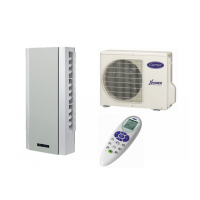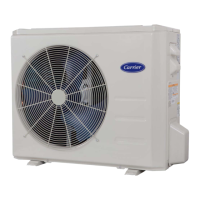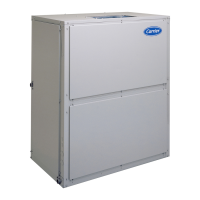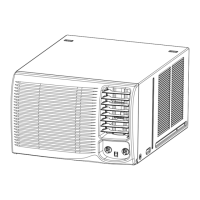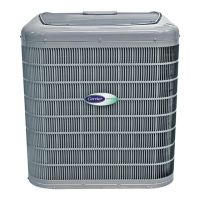R4A4S, R4A5S: Installation Instructions
Manufacturer reserves the right to change, at any time, specifications and designs without notice and without obligations.
4
Install Liquid-Line Filter Drier Indoor
Refer to Fig. 3 and install filter drier as follows:
1. Braze 5-in. liquid tube to the indoor coil.
2. Wrap filter drier with damp cloth.
3. Braze filter drier to above 5-in. (127 mm) liquid tube. Flow arrow
must point towards indoor coil.
4. Connect and braze liquid refrigerant tube to the filter drier.
A05178
Fig. 3 – Liquid Line Filter Drier
Evacuate Refrigerant Tubing and Indoor Coil
Refrigerant tubes and indoor coil should be evacuated using the
recommended deep vacuum method of 500 microns. The alternate triple
evacuation method may be used (see triple evacuation procedure in
service manual). Always break a vacuum with dry nitrogen.
Deep Vacuum Method
The deep vacuum method requires a vacuum pump capable of pulling a
vacuum of 500 microns and a vacuum gage capable of accurately
measuring this vacuum depth. The deep vacuum method is the most
positive way of assuring a system is free of air and liquid water. A tight
dry system will hold a vacuum of 1000 microns after approximately 7
minutes. See Fig. 4
A95424
Fig. 4 – Deep Vacuum Graph
Mandatory Requirements
Pressure Proof Check
1. Preform a pressure check of the unit with a nitrogen charge of about
200psi.
2. The Nitrogen holding charge must NOT decrease in pressure for 1
hour, as indicated by the test gauge. The measuring test gauge
resolution not exceeding 5% of the holding charge.
Leak Check
This leak check requires a vacuum pump capable of pulling a vacuum of
at least 500 microns and a vacuum gage capable of accurately measuring
this vacuum depth.
1. Vacuum unit to 500 microns.
2. When isolating the unit from the pump, the pressure shall not rise
above 1500 microns in 10 minutes.
Final Tubing Check
IMPORTANT: Check to be certain factory tubing on both indoor and
outdoor unit has not shifted during shipment. Ensure tubes are not
rubbing against each other or any sheet metal or wires. Pay close
attention to feeder tubes, making sure wire ties on feeder tubes are
secure and tight.
Installing with Indoor Piston
Outdoor Unit Connected to Factory Approved Indoor Unit
Check piston size shipped with indoor unit to see if it matches required
indoor piston size. If it does not match, replace indoor piston with
correct piston size.
The piston included with the FMA, FMC and FMU fan coils are unique
to those products and CANNOT be replaced with the piston shipped
with outdoor unit. Refer to the AHRI Directory to check if a certain
combination can use a piston or requires an accessory TXV.
When changing indoor piston, use a back−up wrench. Hand tighten hex
nut, then tighten with wrench 1/2 turn. Do not exceed 30 ft−lbs. The
indoor piston contains a Teflon ring (or seal) which is used to seat
against the inside of distributor body, and must be installed properly to
ensure proper seating. See Fig. 5
A10342
Fig. 5 – Indoor (Cooling) Piston
CAUTION
!
UNIT DAMAGE HAZARD
Failure to follow this caution may result in equipment damage or
improper operation.
1. Installation of filter drier in liquid line is required.
2. Filter drier must be wrapped in a heat-sinking material such as a wet
cloth while brazing.
CAUTION
!
UNIT DAMAGE HAZARD
Failure to follow this caution may result in equipment damage or
improper operation.
Never use the system compressor as a vacuum pump.
WARNING
!
FIRE HAZARD
Failure to following this warning could result in personal injury, death
and/or property damage.
DO NOT USE FLAMES OR IGNITION SOURCES TO LEAK
CHECK.

